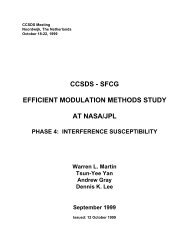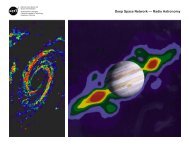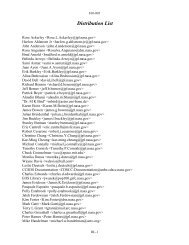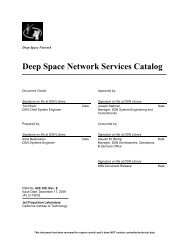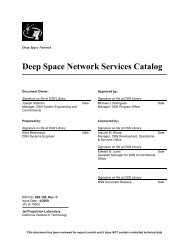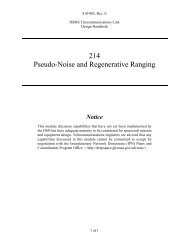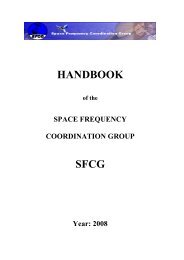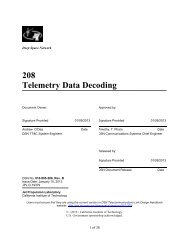Handbook Introduction - Deep Space Network - Nasa
Handbook Introduction - Deep Space Network - Nasa
Handbook Introduction - Deep Space Network - Nasa
You also want an ePaper? Increase the reach of your titles
YUMPU automatically turns print PDFs into web optimized ePapers that Google loves.
810-005, Rev. E<br />
DSMS Telecommunications Link<br />
Design <strong>Handbook</strong><br />
001<br />
<strong>Handbook</strong> <strong>Introduction</strong><br />
Effective November 30, 2000<br />
Document Owner:<br />
Approved by:<br />
Released by:<br />
[Signature on file in TMOD Library]<br />
TMOD Document Release<br />
Date<br />
1 of 7
810-005, Rev. E<br />
001<br />
Change Log<br />
Rev<br />
Issue Date<br />
Affected<br />
Paragraphs<br />
Change Summary<br />
Initial 1/15/2001 All All<br />
Note to Readers<br />
There are two sets of document histories in the 810-005 document, and these<br />
histories are reflected in the header at the top of the page. First, the entire document is<br />
periodically released as a revision when major changes affect a majority of the modules. For<br />
example, this module is part of 810-005, Revision E. Second, the individual modules also change,<br />
starting as an initial issue that has no revision letter. When a module is changed, a change letter is<br />
appended to the module number on the second line of the header and a summary of the changes is<br />
entered in the module’s change log.<br />
This module supersedes module INT-10 in 810-005, Rev. D.<br />
2
810-005, Rev. E<br />
001<br />
Contents<br />
Paragraph<br />
Page<br />
1 <strong>Introduction</strong>....................................................................................................................... 3<br />
1.1 Purpose .................................................................................................................... 3<br />
1.2 Scope........................................................................................................................ 3<br />
1.3. Distribution.............................................................................................................. 4<br />
2 General Information .......................................................................................................... 4<br />
2.1 Constraints............................................................................................................... 4<br />
2.2 Types of Data.......................................................................................................... 5<br />
2.3 Proposed Capabilities .............................................................................................. 5<br />
2.4 Document Layout .................................................................................................... 5<br />
2.5 Module Revision and Control.................................................................................. 6<br />
2.6 Abbreviations........................................................................................................... 6<br />
2.7 Applicable Documents............................................................................................. 6<br />
2.7.1 DSMS External Documents........................................................................ 6<br />
2.7.2 DSMS Internal Documents ........................................................................ 7<br />
1 <strong>Introduction</strong><br />
1.1 Purpose<br />
This modular handbook has been approved by the <strong>Deep</strong> <strong>Space</strong> Mission Systems<br />
(DSMS) Engineering Program Office and is published as a source of interface design data for all<br />
flight projects using the <strong>Deep</strong> <strong>Space</strong> <strong>Network</strong> (DSN). It provides information useful to flight<br />
projects contemplating the design of hardware and software, with reasonable assurance that the<br />
resulting project telecommunications interfaces will be compatible with the established or<br />
planned DSN configurations.<br />
1.2 Scope<br />
The handbook consists of modules that present technical information applicable<br />
to the current DSN configuration and preliminary information applicable to future DSN<br />
configurations. These modules will be revised to reflect new capabilities and distributed to all<br />
users as these capabilities become approved by the DSMS Engineering Program Office.<br />
3
810-005, Rev. E<br />
001<br />
This handbook is primarily concerned with performance parameters of equipment<br />
that supports the forward and return telecommunications link interfaces between spacecraft and<br />
the DSN. Other interfaces, such as ground data interfaces and administrative interfaces, are<br />
covered in a companion handbook, the Telecommunications and Mission Operations Directorate<br />
(TMOD) Document 810-007, DSMS Mission Interface Design <strong>Handbook</strong>.<br />
1.3. Distribution<br />
This handbook is published as an electronic document. However, organizations or<br />
individuals under contract to, or having received a request for proposal from, the National<br />
Aeronautics and <strong>Space</strong> Administration (NASA) or one of its centers, may receive loose-leaf<br />
bound printed copies upon request to the DSMS Engineering Program Office or the editor of this<br />
document. Persons receiving printed copies will normally be notified of revisions by electronic<br />
mail but may also request delivery of printed revisions.<br />
Persons having no further use for printed copies of the document are requested to<br />
return them to the editor of this document. The purpose of this request is to minimize the<br />
possibility of documents remaining in circulation if they are not being maintained. Requests for<br />
mailing address changes should also be submitted to the editor of this document.<br />
2 General Information<br />
2.1 Constraints<br />
The disclosure of a capability by this handbook does not ensure that it can be<br />
made available to all potential DSN users. Specific support commitments must be negotiated<br />
between individual flight projects and the TMOD Plans and Commitments Office. Details about<br />
this office, names for personnel to contact, and their electronic addresses are available at the<br />
following website: . Furthermore, this handbook does<br />
not relieve projects of the responsibility for obtaining frequency spectrum support for their<br />
equipment designs. This spectrum support is obtained through the JPL Frequency Manager,<br />
who is resident in the Plans and Commitments Program Office .<br />
In seeking viable solutions to telecommunications or data-processing problems,<br />
flight projects are not necessarily constrained by the effective design parameters contained in this<br />
handbook. However, flight project requirements that could require DSN interface design beyond<br />
what is specified by this handbook are subject to negotiation with the Plans and Commitments<br />
Program Office.<br />
The term user appears throughout this handbook whenever a mode of operation<br />
or parameter must be selected by a flight project. It must be understood that it is only in rare<br />
cases that these decisions can be made in real time. All DSN activities are planned well in advance<br />
and conducted by highly skilled persons trained in handling contingencies. Changes to planned<br />
operations must be made in accordance with DSN procedures that are beyond the scope of this<br />
document.<br />
4
810-005, Rev. E<br />
001<br />
2.2 Types of Data<br />
It is the intent of this handbook to provide data verified by measurement and,<br />
therefore, representing actual performance. Unless clearly marked to the contrary, data in this<br />
handbook should be assumed to comply with this intent.<br />
Sometimes it is necessary to include DSN design performance data that have not<br />
been verified by measurement. These data will be clearly identified in the associated text or by<br />
appropriate marking.<br />
As hardware and software are tested and evaluated under operational conditions<br />
throughout the DSN, performance parameters will be upgraded to represent actual performance<br />
and published in the next revision of the appropriate module.<br />
2.3 Proposed Capabilities<br />
Whenever sufficient information is known about a capability being implemented in<br />
the DSN and having adequate maturity to be considered for spacecraft mission and equipment<br />
design, this information will be included in the appropriate modules under the heading of<br />
Proposed Capabilities. Telecommunications engineers are advised that anything discussed under<br />
this heading cannot be committed to except by negotiation with the TMOD Plans and<br />
Commitments Program Office.<br />
2.4 Document Layout<br />
The modules in this revision of 810-005 have been divided into major sections that<br />
can be identified by their module numbers and the color of the tabs in the printed version or the<br />
index to the on-line version.<br />
This module is part of an introductory section that may be expanded in the future<br />
to include tutorial or summary information. Modules in this section have yellow tabs and<br />
numbers starting with 0.<br />
The next section, <strong>Space</strong> Link Interfaces, contains modules that provide<br />
information to those concerned with antenna selection and propagation effects. Modules in this<br />
section have blue tabs and numbers starting with 1.<br />
The third section, Station Data Processing, contains modules that provide<br />
capabilities and performance of equipment installed in the Signal Processing Center (SPC) portion<br />
of each DSN location. This information will be of interest both to telecommunications engineers<br />
and spacecraft mission designers. Modules in this section have green tabs and numbers starting<br />
with 2.<br />
The fourth section in this revision, Ground Station Properties, contains modules<br />
that provide information about the underlying technologies relating to many of the <strong>Space</strong> Link<br />
Interfaces and Station Data Processing modules. These modules have been grouped to consolidate<br />
this information in one place. Modules in this section have brown tabs and numbers starting with<br />
3.<br />
5
810-005, Rev. E<br />
001<br />
2.5 Module Revision and Control<br />
The modules contained in this handbook are approved for publication under the<br />
authority of the cover page signatories. Revisions are indicated by a revision letter following the<br />
module designator.<br />
A summary of the changes and additions to the on-line version of 810-005 can be<br />
accessed on the home page of the document, located at the website listed on the cover and title<br />
page of this document. Currency of modules in printed copies can be verified against the<br />
information in the Table of Contents supplied with each revision or by comparison with the online<br />
version. Minor corrections or changes to printed copies may be issued in the form of module<br />
change pages that will be appropriately marked and recorded in a Change Log near the front of<br />
the module.<br />
Persons requesting additions of modules to the handbook should direct their<br />
request to the DSMS Engineering Program Office. Persons requesting changes, corrections, or<br />
additions to existing modules should direct their comments to either of the cover page signatories<br />
or to their functional titles at the DSMS Engineering Program Office. All modules are subject to<br />
the review and approval process of TMOD Standard Practice, DSMS Documentation Structure,<br />
Standards, and Definitions; TMOD Document 810-001.<br />
2.6 Abbreviations<br />
Abbreviations are normally defined after their first textual usage and are compiled<br />
in module 901, <strong>Handbook</strong> Glossary. It should be recognized, however, that certain common<br />
abbreviations or acronyms used in this handbook may not defined. External users may refer to<br />
any of several compilations of electronic terms for omitted definitions. Users with access to the<br />
JPL Intranet can find additional abbreviations in DSMS System Engineering Standard; DSMS<br />
Abbreviations and Acronyms, TMOD Document 820-062.<br />
2.7 Applicable Documents<br />
The latest issues of the following documents are referenced by modules in this<br />
handbook or are the source of requirements for this handbook or the capabilities described herein.<br />
2.7.1 DSMS External Documents<br />
The following documents either are public documents or may be made available to<br />
organizations or individuals under contract to, or having received a request for a proposal from,<br />
NASA or one of its centers.<br />
1. The Telecommunications and Mission Operations Progress Report, On-line<br />
document <br />
2. DSMS Standard Practice, DSMS Mission Interface Design <strong>Handbook</strong>; TMOD<br />
Document 810-007<br />
6
810-005, Rev. E<br />
001<br />
3. DSMS Requirements and Design, DSMS External Interface Specification; TMOD<br />
Document 820-013<br />
2.7.2 DSMS Internal Documents<br />
The following DSMS internal documents are referenced by, or provide<br />
requirements for, this handbook and may be found at the Product Data Management System<br />
website .<br />
1. TMOD Standard Practice, DSMS Documentation Structure, Standards, and<br />
Definitions; TMOD Document 810-00l<br />
2. DSMS System Engineering Standard, DSMS Abbreviations and Acronyms;<br />
TMOD Document 820-062<br />
3. DSMS Subsystem Requirements and Design; TMOD Document Series 834<br />
7



